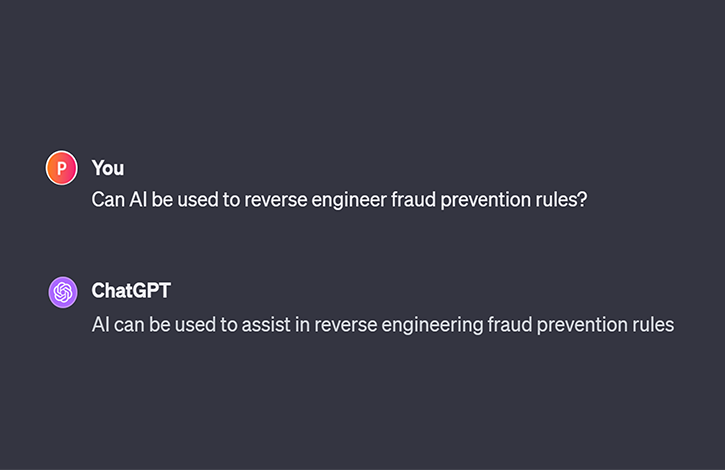Share this
NO RULES: How AI Renders Rule-Based Fraud Prevention Obsolete
by Pipl Team on Dec 1, 2023

The landscape of fraud prevention is undergoing a seismic shift with the advent of artificial intelligence (AI). In an era where fraudsters increasingly leverage AI to reverse-engineer and bypass traditional rule-based systems, organizations must adapt by embracing a more sophisticated, AI-driven approach to digital identities.
The Mechanics of Machine Learning: Beyond Rules
Machines learn by examples. If you were to create a rule to identify a dog as “something with four legs and two eyes and a head” it wouldn’t always be accurate because a dog with three legs is still a dog. A dog with one eye is still a dog.
As humans, we can identify a dog from different angles or by viewing just part of the animal, like its head.

For a human it is easy to identify which of these images is a Chihuahua and which is a muffin. But if you try to write a rule for that identification to be done by a computer, you’ll realize it's extremely difficult.
As humans, we're still able to recognize these pictures of dogs because we’ve seen thousands of dogs. We’ve “learned” what a dog looks like.
When we're talking about machine learning, we mean giving a computer examples (whether that’s faces, voices, objects etc), then telling it whether something is or isn't something. By the time the machine has seen 100,000 examples, it's probably better than any humans at being able to distinguish between what is a dog and what is not a dog.
Creating Classifications
When you think about an algorithm that is supposed to make a decision on whether a video has a dog or not, that machine has watched millions of hours of videos on YouTube with and without dogs. It can recognize a dog. Not because it has a set of rules for what a dog is.
It can identify the dog because it has seen dogs in so many videos, formats, variations, lighting conditions, and angles, that it can easily recognize a dog much faster and much more accurately than a human. So, even if the dog is in the dark, it's in a weird position, the computer would still recognize it.
The flexibility of this learning is why learning from examples is superior in creating classification than any set of rules.


Comparing the chihuahua to the muffin, you can see how these classifications or descriptions are being used to identify the items. Computers and humans will say a muffin is bread, dessert, food, and cake. In classifying a chihuahua, both humans and computers will say it’s an animal, a canine, a dog, a mammal, and a pet.
The Limitation of Rules
Artificial intelligence has made rules easy to find and bypass. It can quickly and easily draw conclusions from disparate data. It can unpack how items were organized.
The fundamental flaw in rule-based systems is their predictability and simplicity, which AI can easily exploit. Consider the following task. You want to classify a set of foods for a school sack lunch. You provide a list of foods that are approved by your kid’s school and a list that are declined.

You’re at the grocery store and want to choose foods that aren’t on either list, so you feed that new list of foods into ChatGPT to tell you whether or not you can send your kid to school with them.
| List 1: Approved | List 2: Declined | List 3: Unknown |
|
|
|
The logic for why each food is on the list might not make sense to you at first, but to ChatGPT, it figures out the rule in less than a second.
ChatGPT reveals that the categorizations are based on similarities in consumption patterns. Meaning, List 1 can be eaten raw or cooked. List 2 is typically consumed cooked. Therefore the rule is that if you typically eat it raw, it should go into List 1 - approved, and if it needs to be cooked or warmed, it goes into List 2 - declined.
Based on that rule, broccoli, pineapple, and peaches are added to List 1. Yams and pine nuts are added to List 2.

As a human this list may not be obvious, but to a computer it is. And once you know it, the rule is simple and easy to follow. Such swift rule identification makes traditional systems easy targets for AI-empowered fraudsters.
Beyond Pre-Defined Rules
The solution to defeating fraudsters lies in adopting AI methodologies that don't rely on predetermined rules. When you use machine learning (as seen in the chihuahua versus muffin example) you can see when the system learns from a multitude of examples to classify objects, often considering data points that may not be immediately apparent or even known to human developers, this will ensures that the system's decision-making process is not only accurate but also incredibly complex to reverse-engineer.
The Power of AI in Fraud Detection
In the context of fraud detection, this AI-driven approach translates to a system where no explicit rules are set for identifying fraudulent activity. Instead, the AI model learns from vast amounts of data, encompassing various examples of legitimate and fraudulent behaviors. This learning process enables the system to identify subtle patterns and anomalies that might escape rule-based systems.
The Deterrent Effect: Cost and Time
The complexity and unpredictability of AI-driven systems serve as a significant deterrent to fraudsters. The time and effort required to decipher the workings of such a system are often prohibitive, rendering attempts at manipulation unfeasible. The goal is not to create an unbreakable system but to ensure that breaking it would require an impractical amount of resources and time. This principle is critical in an era where traditional, rule-based systems are easily compromised using AI tools.
Staying Ahead in the AI Arms Race
The shift to AI-driven security systems is not just an upgrade; it's a necessary evolution to stay ahead in the ongoing arms race against increasingly sophisticated fraudsters. While any system has its vulnerabilities, AI's inherent complexity and adaptability make it a formidable tool in the fight against fraud.
Learn More
This blog only scratches the surface of the potential of AI in fraud detection. For those interested in exploring more advanced examples and gaining deeper insights, we invite you to contact us at trust@pipl.com for access to the complete recording of our discussions on this topic. Join us in exploring the cutting edge of AI-driven security solutions.
 All Posts
All Posts